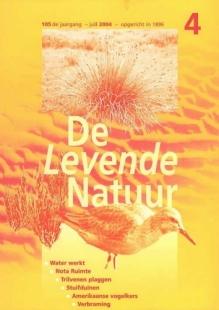De Levende Natuur nummer 4 van 2004 (English summary)
Afbeelding

Water at work: environmental rehabilitation of brooks on ice moraines and marshes in adjacent polders along the river Waal
Saris, F.J.A., R.S.E.W. Leuven & M.C. de Vriend
Water and nature management of rural and urban areas on ice moraines and in adjacent polders along the river Waal in The Netherlands have to cope with several environmental problems, such as desiccation of nature areas, uncontrolled emission of storm water from sewerage systems and soil erosion. The present paper describes the outline and preliminary results of an innovative project aiming at integrated and sustainable water management. Important environmental rehabilitation measures were (1) decrease of desiccation by reduction of rain water run off and water retention; (2) emission reduction by decrease of storm water frequency and hydraulic load of wastewater treatment plant; (3) nature development by revitalisation of brooks, increase of groundwater levels in polder areas and creation of nature areas and ecological corridors; and (4) increase of recreational attractiveness of rural and urban areas and landscape-ecological, cultural and historical values by creation of brooks, pools and marshes and making visible traditional functions of water in villages. Important success factors of this project were integrative planning, intensive communication, public-private participation in planning and execution phases and spirit of a small local government to innovate their water and nature management and to raise various national and international funds.
A new spatial planning, the so called Nota Ruimte
Dirkx, G.H.P. & R. Kuiper
In the ‘Nota Ruimte’ the new spatial planning of the Dutch government has been described. This document has restricted consequences for the spatial protection of nature reserves as it roughly continues the policy concerning nature protection from earlier spatial planning documents. In continuing the existing spatial nature protection policy, also the bottlenecks of this policy seem to be continued. One of the bottlenecks is the poor implementation of the national policy in municipal spatial allocation plans. Many of these plans are still allowing building activities in the areas that are a part of the ecological network. New is the balance approach which offers possibilities to approve undesirable plans in nature reserves, as long as they are combined with plans that will improve nature quality. The approach may be profitable for nature protection. Opportunities may be created to remove disturbing activities from vulnerable areas to less vulnerable areas, in exchange for their extension. However, there exists also a risk that this approach will be used to avoid the strict legislation for nature reserves.
A plea for small scale management measures in fen ecosystems
Beltman, B. & T. van Noordwijk
Acidification and eutrophication cause severe losses of characteristic species and plant communities in fens and fen-meadows. Some Sphagnum species and Polytrichum commune increase in percentage cover and make profit of the new habitat conditions. Sod cutting is applied as management measure to reduce unwanted developments, however the results are seldomly positive regarding the return of rare and Red List species. The research presented showed in small scale sod cutting strips the species richness is 21 - 29 species whereas in the control the number is c. 15. The pH in the sod cut area is above 6 and is in the control between 3.7 and 4.5. The 11-year old experiment is still successful presumably because it is regularly flooded. Flooding brings calcium-rich and nutrient-poor water in and over the soil and prevents re-acidification. Fluctuating water levels as management tool can help to flood areas with water of the proper quality and prevent re-acidification and losses of habitat conditions for fen plant communities.
Soil life forwards black-cherry plague
Putten, W. van der & F. Rienks
Black cherry (Prunus serotina) is a normal forest tree species in Northern America, while it has become a plague after introduction in Dutch forests. The difference is caused by the soil life. In the original forests, soil fungi of the genus Pythium prevent seedling establishment in the vicinity of parent trees. These fungi are absent, or not active, in Dutch forests. Therefore, escape from its natural enemies seems to be an important cause of the invasive behaviour of this introduced plant species. Instead of being controlled by soil pathogens, the tree appears to benefit from local soil organisms in its introduced range.
Bramble dominance: its causes and ecological status
Bijlsma, R.J.
Bramble dominance (by Rubus fruticosus agg.) in forests is generally regarded as a nuisance by ecologists. Historical references suggest that dominance by bramble is not a recent phenomenon but occurred commonly in both coppice woods and high forest in northwestern Europe. It is restricted to (weakly) acid, well-drained soils and with at least 5 % light availability on the forest floor. Under these conditions, long lasting bramble dominance occurs in forests with a uniform structure (such as even-aged pine plantations and former oak coppices without shrub layer) and low grazing pressure. Mainly species from the subsection Hiemales contribute to the formation of thickets, most notably Rubus macrophyllus (series Sylvatici). Species from the series Vestiti and Pallidi survive at irradiance levels of about 2 % but are outcompeted by species from the series Sylvatici and Rhamnifolii above 5 % light availability. The apparent increase of brambles and bramble dominance in the Netherlands is due to dessiccation of woodland types with (until recently) periodically high groundwater levels. Another reason is the aging of heathland afforestations with Scots pine and the declining vitality of oak forests including former coppice woodlands. It is concluded that bramble dominance is an integral part of woodland development where grazing intensity is low. The restricted (regional) distribution of many bramble species, the occurrence of several ancient woodland brambles and the ecological diversity between bramble species is insufficiently acknowledged by ecologists.

